Abstract
CCCH zinc finger proteins play critical roles in plant growth, development and stress responses. Here, 56 CCCH genes were identified in Morus alba. These genes displayed wide variation in coding sequence (456–6318 bp) and protein length (151–2105 aa), with most proteins predicted to localize in the nucleus and a few in chloroplasts, the endoplasmic reticulum or cytoplasm. Chromosomal mapping showed uneven distribution across 14 chromosomes, with tandem clusters on chromosomes 1, 6 and 13. Phylogenetic analysis classified 53 MaC3Hs into 13 subfamilies, while three genes remained ungrouped. Synteny analysis revealed four segmental duplication events, suggesting segmental duplication as the major expansion mechanism, under purifying selection. Comparative collinearity showed higher conservation with Arabidopsis thaliana than with rice or maize. Promoter analysis identified 22 cis-acting elements, mainly related to phytohormones, followed by abiotic stress and developmental regulation. Expression profiling under drought stress revealed differential expression across tissues, with MaC3H33 showing strong induction (>200-fold in stems on day 6). Subcellular localization confirmed MaC3H33 is nuclear, and yeast assays indicated no self-activation. These findings provide comprehensive insights into the MaC3H gene family and lay a foundation for functional studies related to drought tolerance in mulberry.
1. Introduction
As one of the most abundant and versatile families of transcriptional regulators in eukaryotes, zinc finger proteins are defined by their nucleic acid-binding capability, which allows them to control various processes of gene expression []. Among these proteins, the CCCH zinc finger proteins, identified by their distinctive cysteine cysteine cysteine histidine (CCCH) motif, represent a notable subgroup due to their involvement in RNA metabolism and post-transcriptional regulatory processes []. These proteins are associated with various key biological functions, including DNA protein and RNA protein []. Their significant regulatory roles underscore their importance in plant growth, developmental processes [] and particularly stress response mechanisms [].
Extensive research in plants has revealed that CCCH zinc finger proteins play essential roles in diverse developmental and physiological processes. They are known to regulate key stages of plant growth, including seed germination [,], flowering [] and secondary wall synthesis [], reflecting their broad and critical involvement in plant biology. For example, in Arabidopsis, AtC3H59 influences multiple processes, including seed germination, seedling growth and seed development []. In wintersweet (Chimonanthus praecox), the CpC3H3 gene promotes flowering and enhances the plant’s drought resistance [,]. In addition to their roles in development, CCCH proteins have attracted considerable interest for their ability to regulate plant responses to abiotic stresses, including drought [], salinity [,], low temperature [] and oxidative damage [], thereby highlighting their essential contribution to plant resilience and survival under adverse environmental conditions. For example, OsTZF5 is a key regulator that enhances rice tolerance to drought and cold stress [,]. In Arabidopsis, AtC3H3 modulates salt stress responses by regulating the expression of salt tolerance related genes [].
CCCH zinc finger proteins are particularly important in mediating drought responses, a critical consideration given that water deficit remains one of the most severe environmental stresses affecting plant development, yield and geographic range worldwide []. To survive drought stress, plants employ intricate adaptive mechanisms at the molecular, biochemical and physiological levels, in which both transcriptional and post-transcriptional regulators are key contributors []. Previous studies conducted on various plants such as rice [], alfalfa (medicago sativa L.) [] and poplar (Populus ussuriensis) [] have illustrated the diverse roles of CCCH zinc finger proteins in regulating gene expression in response to drought stress, thereby modulating plant resilience and adaptation to water deficit conditions. For example, overexpressing MsC3H29 in alfalfa significantly enhances primary root elongation and fresh biomass of transgenic hairy roots, and promotes drought resistance of alfalfa hairy roots by reducing ROS accumulation []. In rice, OsTZF7 contributes to drought adaptation by regulating gene expression through ABA signaling pathways [].
Despite the considerable advances in understanding the functional and mechanistic roles of CCCH in model species, the diversity, evolutionary relationship and precise functions of these proteins in non-model and economically important plants remain comparatively underexplored [,]. Mulberry (Morus alba L.) is one such economically significant plant that has attracted attention due to its ecological, agricultural and commercial importance []. Mulberry leaves serve as the primary food source for the silkworm (Bombyx mori), which underpins the silk industry. Additionally, the plant exhibits pharmaceutical properties with potential benefits for human health []. Furthermore, mulberry is known for its resilience to various environmental stresses, including drought, highlighting the importance of understanding the molecular basis of their stress tolerance mechanisms [].
Currently, there is a lack of comprehensive genomic and functional research on CCCH in mulberry, and their specific contributions to plant growth, developmental processes, and stress tolerance remain largely unexplored. Therefore, identifying and characterizing the CCCH genes in mulberry is crucial for understanding their potential contributions to mulberry biology and stress tolerance mechanisms. Such information could ultimately facilitate genetic improvement strategies aiming to enhance drought tolerance and overall resilience in mulberry and related plant species. In this context, the present study aimed to systematically identify and characterize the CCCH zinc finger gene family in mulberry. A total of 56 MaC3H genes were identified in the genome of mulberry. We conducted comprehensive analyses of these genes, including structural features, phylogenetic relationships, promoter cis-elements, chromosomal distribution, microsynteny, subcellular localization and transcriptional activity. Considering the well-documented involvement of CCCH proteins in drought stress regulation in other plant species, we next analyzed the expression profiles of selected MaC3H genes in mulberry seedlings subjected to drought treatment. Using quantitative real-time PCR (qRT-PCR), we profiled their dynamic expression across different tissues (roots, stems and leaves) and at multiple time points during drought treatment. To better elucidate the functional role of MaC3H proteins, a gene MaC3H33 that exhibits significant induction under drought stress was selected for further molecular characterization, exploring its subcellular localization and transcriptional activity. By combining genomic analyses, gene expression profiling and detailed molecular characterization, this study offers a comprehensive understanding of the potential roles of MaC3H genes in enhancing mulberry’s adaptability to environmental stresses, offering valuable foundations for future functional genomic studies and genetic improvement efforts in mulberry and beyond.
2. Results
2.1. Identification of the MaC3H Genes
Using BLASTP program identification, as well as Pfam and SMART verification, we identified 56 members of the MaC3H gene family (MaC3H1–MaC3H56). Detailed characteristics of these mulberry CCCH genes are provided in Table S1, including coding sequence (CDS) length, protein size, isoelectric point (pI), molecular weight (MW) and predicted subcellular localization. The CDS length varied from 456 bp in MaC3H40 to 6318 bp in MaC3H34, corresponding to protein lengths ranging between 151 and 2105 amino acids. The calculated molecular weights extended from 17,106.22 Da in MaC3H40 to 232,685.74 Da in MaC3H34. The theoretical pI values spanned from 4.73 in MaC3H54 to 9.68 in MaC3H15. Subcellular localization prediction indicated that 39 proteins were exclusively nuclear, seven were distributed between the nucleus and chloroplast, four were targeted to mitochondria, one localized to the cytoplasm, and another was present in both the endoplasmic reticulum and nucleus.
A total of 57 sequences containing the C-X8-C-X5-C-X3-H motif and 43 sequences containing the C-X7-C-X5-C-X3-H motif were analyzed separately, and sequence logos were generated for each group (Figure 1). To investigate the structural features of CCCH motifs in MaC3H proteins, these motifs were compared with their homologs in A. thaliana and O. sativa. Composite sequence logos for the two motifs were also constructed, which clearly demonstrated a high level of conservation. Across all three motif types, four amino acid residues were found to be absolutely conserved, consistent with the motif profiles reported in the Pfam and SMART databases. Nevertheless, certain differences in motif characteristics were noted across the three plant species. For instance, in the M. alba C-X7-C-X5-C-X3-H motif logo, lysine was more frequently present at the C1+11 position than arginine, whereas the opposite pattern was observed in A. thaliana and O. sativa.
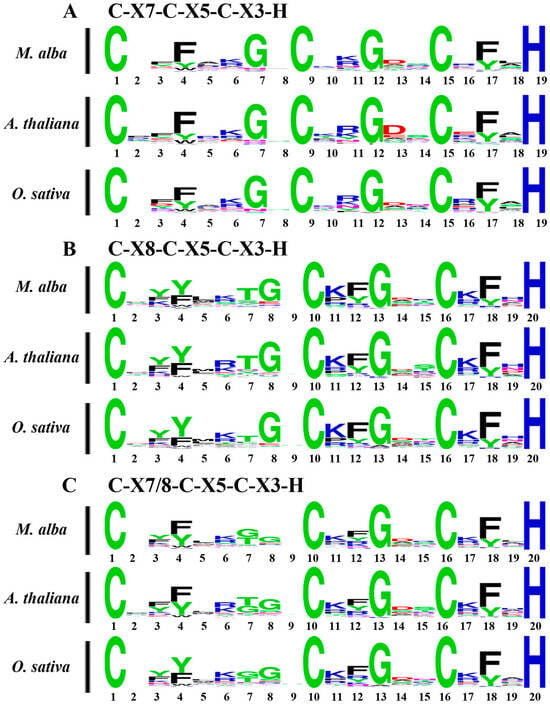
Figure 1.
Sequence logos for common CCCH zinc finger motifs. (A) C-X7-C-X5-C-X3-H motifs of M. alba, A. thaliana and O. sativa. (B) C-X8-C-X5-C-X3-H motifs of M. alba, A. thaliana and O. sativa. (C) C-X7-C-X5-C-X3-H and C-X8-C-X5-C-X3-H motifs of M. alba, A. thaliana and O. sativa. The conservativeness of amino acids in different positions is indicated by the size of the characters.
The chromosomal localization of MaC3Hs was analyzed, revealing an uneven distribution across the 14 chromosomes of mulberry (Figure 2). Chromosome 6 harbored the largest number of MaC3Hs (9), whereas chromosome 12 contained only one. Notably, many MaC3Hs were arranged in tandem clusters on the chromosomes. For instance, tandem clusters composed of two MaC3Hs were identified on chromosomes 1, 6 and 13.
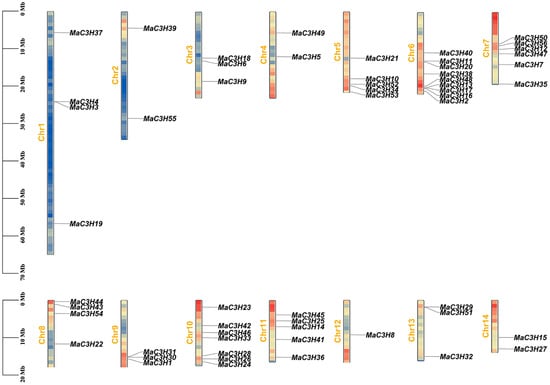
Figure 2.
Chromosomal distribution of MaC3H gene family in mulberry. The scale on the left is in mega-bases. The gene names on chromosomes of right side represent the approximate locations of each MaC3H genes.
2.2. Phylogenetic Relationships
To investigate the evolutionary relationships of mulberry CCCH-type zinc finger proteins, an unrooted phylogenetic tree was generated using the 56 predicted protein sequences, with 1000 bootstrap replicates providing statistical support (Figure 3) []. On the basis of bootstrap values greater than 100, these proteins were clustered into 13 subfamilies, designated CCCH (A-M). However, the MaC3H5, MaC3H38 and MaC3H56 genes were not assigned to any of these subfamilies, as their bootstrap support with other genes was below 100, a phenomenon also observed in CCCH genes of other plant species []. Among the defined groups, subfamily E represented the largest clade, containing 10 members. Subfamilies A and B each consisted of 8 proteins, while subfamily C included 4. Subfamilies D, F, H, I and K harbored 3 members apiece, whereas the remaining subfamilies (G, J, L and M) contained only 2 proteins each.
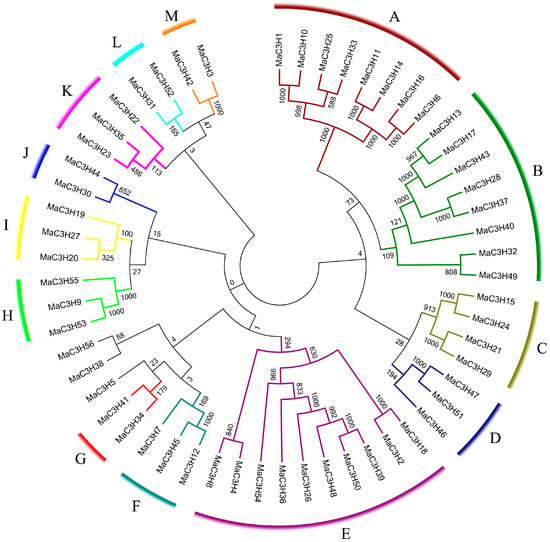
Figure 3.
Phylogenetic analysis of CCCH in mulberry. 56 MaC3H genes are divided into 13 subfamilies (A–M).
2.3. Motif and Gene Structure Analysis of MaC3Hs
To gain deeper insight into the characteristics of MaC3Hs, we analyzed the motif composition as well as the intron–exon organization of each gene in this family. The presence of conserved motifs indicated that all MaC3H proteins contained at least one of motifs 1, 2, 4, 5, 7, 8 or 10, which correspond to the CCCH zinc finger domains, thereby confirming the accuracy of the identification of MaC3H genes in mulberry. The number and type of motifs were highly similar across the 13 subfamilies, although each subfamily exhibited distinct structural features (Figure 4A, Table S2). Members of the A subfamily consistently contained motifs 1, 2 and 4, and, except for MaC3H36, motif 9 was predominantly present in this group. Motif 6 was exclusively detected in five genes (MaC3H13, MaC3H17, MaC3H28, MaC3H37 and MaC3H43) of the B subfamily. Genes belonging to the M subfamily possessed an identical number and type of motifs, which were located at conserved positions within the genes. Analysis of the intron–exon structures of the MaC3H genes revealed that only five genes (MaC3H1, MaC3H10, MaC3H16, MaC3H25 and MaC3H33) in the A subfamily lacked introns, whereas the remaining genes contained between 1 and 13 introns (Figure 4B). Within each subfamily, the intron–exon organization was relatively conserved, with similar or even identical numbers of introns observed among members.
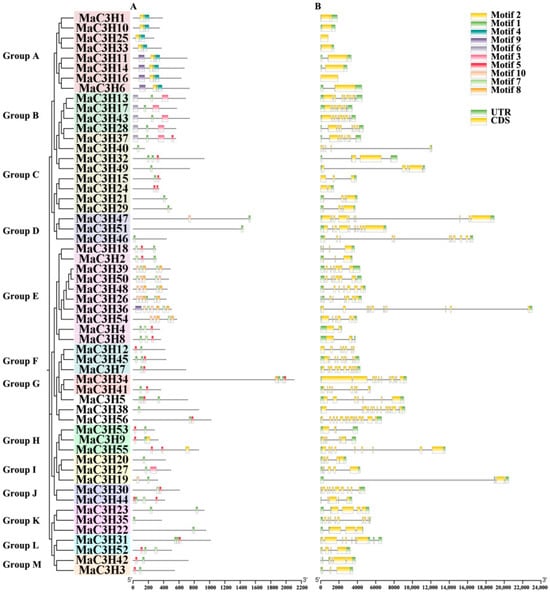
Figure 4.
Conserved motifs and gene structure analysis of the mulberry CCCH gene family. (A) The motif composition of MaC3H proteins. The boxes with different letters and colors represent different sequences, and details of each conserved motif are in Table S2. (B) Exon and intron structures of the mulberry CCCH genes. Exons are indicated by yellow rectangles and introns by grey lines.
2.4. Synteny Analysis of MaC3Hs
Gene family expansion is typically driven by whole-genome duplication, segmental duplication, or tandem duplication events []. To investigate the potential genetic mechanisms underlying evolutionary processes, duplication events within the MaC3H gene family of M. alba were analyzed. Our analysis revealed four segmentally duplicated gene pairs involving eight MaC3H members, suggesting that segmental duplication has been the predominant force contributing to the diversification and expansion of the CCCH gene family in M. alba (Figure 5A, Table S3). To further evaluate the selective pressures acting on these duplicated genes, nonsynonymous (Ka) and synonymous (Ks) substitution rates were calculated with TBtools. As shown in Table S3, the calculated Ka/Ks ratios varied between 0.167 and 0.372, implying that purifying selection has been the major evolutionary constraint maintaining the functional stability of MaC3H genes in M. alba.
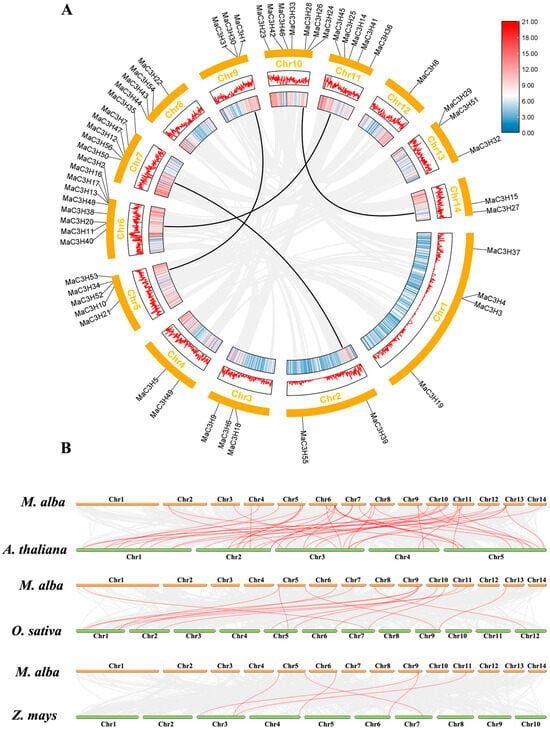
Figure 5.
Synteny analysis of MaC3H genes. (A) Synteny analysis of MaC3Hs in M. alba. The gray lines represent all syntenic blocks in the genome of M. alba, and the black lines represent duplicate MaC3H gene pairs. (B) Synteny analysis of CCCH genes among M. alba, A. thaliana, O. sativa and Z. mays. The chromosomes of M. alba are represented in yellow, while the chromosomes of A. thaliana, O. sativa and Z. mays are represented in green. Gray lines represent the collinear blocks among M. alba, A. thaliana, O. sativa and Z. mays. Red lines indicate the orthologous relationships of CCCH genes among M. alba, A. thaliana, O. sativa and Z. mays.
Additionally, synteny analyses were conducted among CCCH genes in M. alba, A. thaliana, O. sativa and Z. mays to further elucidate the phylogenetic relationships of MaC3Hs. As shown in Figure 5B (Table S4, Table S5 and Table S6), 45 homologous gene pairs were detected between M. alba and A. thaliana, while 13 pairs were identified between M. alba and O. sativa and only 5 pairs were observed between M. alba and Z. mays. The observed greater number of homologous gene pairs between M. alba and A. thaliana likely reflects their closer evolutionary relationship, in contrast to the fewer homologs identified with O. sativa and Z. mays.
2.5. Cis-Acting Element Analysis of MaC3Hs
Gene function is often regulated by cis-acting elements embedded within promoter sequences []. To gain deeper insights into the potential regulatory roles of MaC3Hs in mulberry, we retrieved 2000 bp upstream sequences from the start codon (ATG) of all 56 MaC3H genes and analyzed them using the PlantCARE database. A total of 22 types of cis-acting elements were identified and classified into three major categories: hormone-responsive elements, abiotic stress-responsive elements and elements related to plant growth and development (Figure 6, Table S7). Among these, hormone-responsive elements were the most abundant in the MaC3H promoter regions, including auxin-responsive, abscisic acid-responsive, gibberellin-responsive, jasmonic acid-responsive and salicylic acid-responsive elements. Except for MaC3H35, MaC3H47 and MaC3H54, all promoters contained at least one hormone-responsive element. These findings suggest that MaC3Hs may participate in multiple plant hormone signaling pathways. Elements associated with abiotic stress responses—such as those responsive to wounding, low temperature, drought, anaerobic conditions and general defense or stress signals—were also identified, although their overall abundance was relatively low.
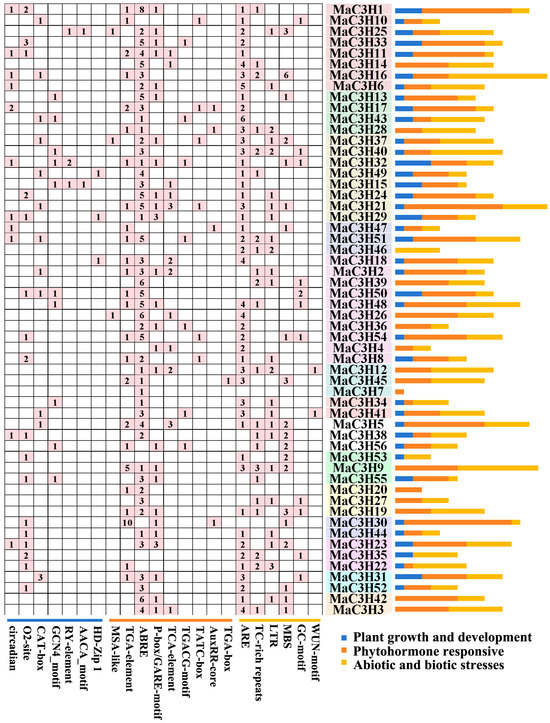
Figure 6.
Analysis of cis-acting elements of MaC3Hs. Analysis of cis-acting elements in the promoter regions of MaC3H genes, numbers indicate the number of cis-acting elements, and histogram of cis-acting elements in each MaC3H genes.
2.6. Functional Annotations of MaC3H Genes
To further elucidate the potential functions of the CCCH gene family in mulberry growth and development, Gene Ontology (GO) enrichment analysis was conducted to predict their participation in diverse biological processes. The identified GO terms included 32 biological processes and eight molecular functions (Figure 7, Table S8). Within the biological process category, the majority of genes were predicted to participate in metabolic processes, particularly RNA metabolism, nucleic acid metabolism and heterocyclic compound metabolism. Notably, these processes were primarily associated with eight genes: XM_024165356.1-0, XM_010110830.1-0, XM_010104852.2-0, XM_024162439.1-0, XM_010090035.2-0, XD_010098254.2-0, XM_010110597.2-0 and XM_010103125.2-0. For molecular function analysis, eight genes were found to be associated with several key functions, including mRNA binding (GO:0003729), RNA binding (GO:0003723), nucleic acid binding (GO:0003676), heterocyclic compound binding (GO:1901363), obsolete organic cyclic compound binding (GO:0097159) and small molecule binding (GO:0036094).
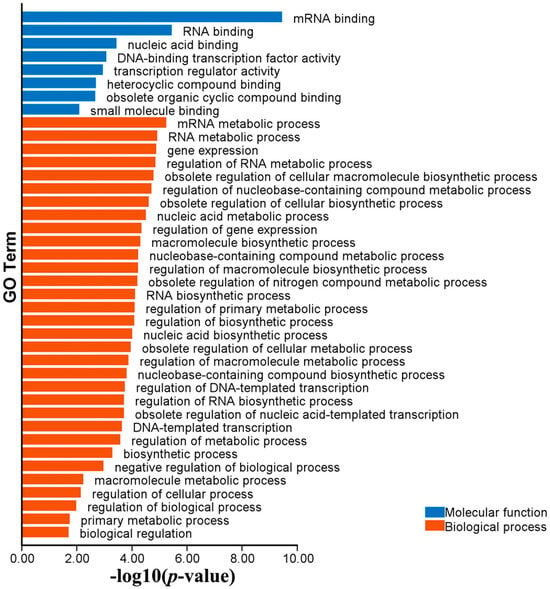
Figure 7.
GO enrichment analyses of MaC3Hs. GO enrichment analysis of the mulberry CCCH genes. Based on the enrichment results, blue and red colors indicate the different categories.
2.7. MaC3H Gene Expression Following Drought Treatment
Previous research has demonstrated that CCCH genes are associated with plant responses to drought stress [,]. To determine whether MaC3H genes contribute to drought tolerance in mulberry, we conducted quantitative real-time PCR (qRT-PCR) to examine their expression patterns in roots, stems and leaves of seedlings subjected to drought for 0, 3, 6, 9 and 12 days. Specific primers used for amplification are provided in Table S9. Based on a phylogenetic analysis of previously reported drought-responsive CCCH genes and MaC3H genes, 17 representative genes were selected for qRT-PCR analysis (Figure S1).
Seventeen genes were upregulated in the roots at various time points following drought treatment, although MaC3H6, MaC3H21, MaC3H19 and MaC3H42 showed no significant differences compared with the control (0 day) (Figure 8A). After three days of drought treatment, eleven genes (MaC3H1, MaC3H2, MaC3H10, MaC3H11, MaC3H15, MaC3H16, MaC3H18, MaC3H24, MaC3H25, MaC3H31 and MaC3H33) reached peak expression levels. Among them, five genes exhibited more than a tenfold increase, and MaC3H33 was upregulated over 70-fold relative to the control, showing a highly significant difference. Four genes (MaC3H6, MaC3H21, MaC3H40 and MaC3H42) reached maximum expression on day 6, while two genes (MaC3H14 and MaC3H29) peaked on day 9.
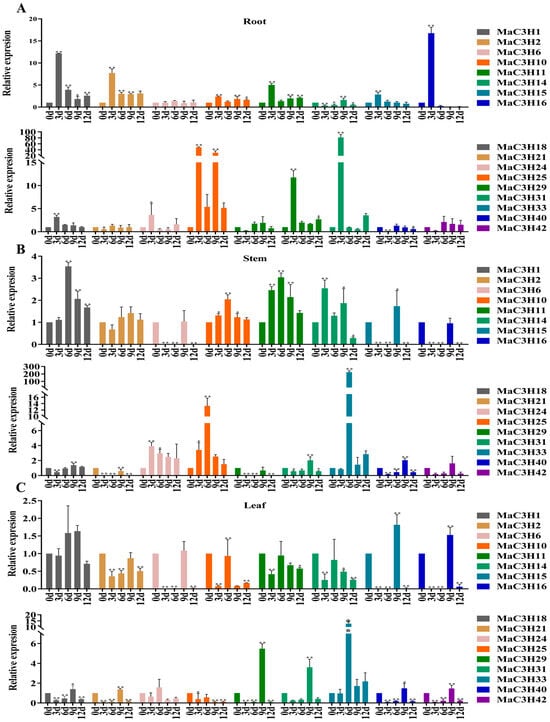
Figure 8.
The expression of MaC3H gene in different parts under drought stress treatment. (A) Expression in the roots. (B) Expression in the stems. (C) Expression in leaves. Y-axis: relative expression levels; X-axis: the time course of drought stress treatments. Statistical significance was determined using a paired Student’s t-test. The mean ± standard error from the mean (SE) of at least three replicates is presented, and significant differences relative to controls are indicated at * p < 0.05 and ** p < 0.01.
In the stems, the expression of three genes (MaC3H16, MaC3H21 and MaC3H29) was suppressed following drought treatment (Figure 8B). On day 9, ten genes (MaC3H2, MaC3H6, MaC3H15, MaC3H16, MaC3H18, MaC3H21, MaC3H29, MaC3H31, MaC3H40 and MaC3H42) reached their highest expression levels, whereas at other time points their expression was either lower than or comparable to that of the control. Additionally, five genes (MaC3H1, MaC3H10, MaC3H11, MaC3H25 and MaC3H33) peaked on day 6 and then declined. Among them, three genes exhibited expression levels more than tenfold higher than the control, with MaC3H33 showing an exceptionally high induction, exceeding 200-fold on day 6. Moreover, MaC3H14 and MaC3H24 peaked on day 3 and displayed significant differences compared with the control.
In the leaves, five genes (MaC3H1, MaC3H10, MaC3H11 and MaC3H33) showed suppressed expression after drought treatment (Figure 8C). Conversely, eleven genes (MaC3H1, MaC3H2, MaC3H6, MaC3H15, MaC3H16, MaC3H18, MaC3H21, MaC3H29, MaC3H31, MaC3H40 and MaC3H42) reached peak expression levels on day 9, but only MaC3H29 and MaC3H31 exhibited more than a twofold increase compared with the control. Additionally, six genes (MaC3H10, MaC3H11, MaC3H14, MaC3H24, MaC3H25 and MaC3H33) reached maximum expression levels on day 6, with MaC3H33 showing a ten-fold increase relative to the control, which was statistically significant. By analyzing the expression level of MaC3Hs, it was found that MaC3H33 exhibited significant responses in different parts under drought stress. Therefore, we will further investigate this gene.
2.8. Subcellular Localization and Transcription Activation Assay
MaC3H33 was selected for subcellular localization and transcriptional activation analyses. To determine its subcellular localization, a MaC3H33-GFP fusion construct was generated and transiently expressed in Nicotiana benthamiana leaves. Fluorescence microscopy revealed that MaC3H33 was exclusively localized in the nucleus (Figure 9).
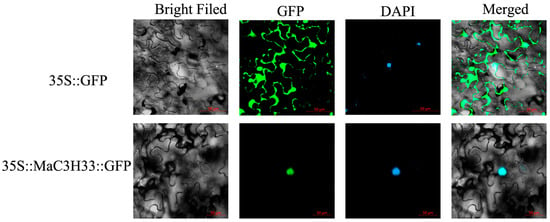
Figure 9.
Subcellular localization analysis of MaC3H33. The images depicted the expression of MaC3H33-GFP fusion protein and GFP (control) in tobacco leaves. The green fluorescent signal of the GFP channel indicated the location of the expressed protein, the bright field showed the cell, the blue signal of DAPI showed the location of the expressed protein in the nucleus and Merged is a merged plot of the former. Scale bar = 50 µm.
For transcriptional activation analysis, the recombinant yeast expression vector MaC3H33-pGBKT7 was constructed and introduced into the yeast strain Y2H. As illustrated in Figure 10, MaC3H33-pGBKT7, together with both positive and negative controls, was able to grow on SD/−Trp medium. In contrast, on selective SD/−Trp/−His/−Ade/X-α-gal plates, only the positive control displayed growth and produced a blue coloration, whereas neither the negative control nor MaC3H33-pGBKT7 exhibited growth. These results demonstrate that MaC3H33 does not exhibit intrinsic transcriptional self-activation activity.
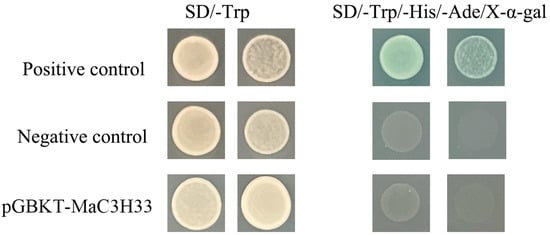
Figure 10.
Transcriptional activation activity of MaC3H33. The fusion proteins of the GAL4 DNA binding (BD) and MaC3H33 were expressed in yeast strain.
3. Discussion
CCCH-type zinc finger proteins have been characterized in several plant species, including Arabidopsis [], rice [], maize [], cucumber (Cucumis sativus L.) [], potato (Solanum tuberosum L.) [] and others. These proteins have been implicated in diverse biological processes, such as plant growth, development and responses to both biotic and abiotic stresses. For example, a new non-tandem CCCH-type zinc finger gene (PbdsZF) was identified in Chinese white pear (Pyrus bretschneideri), which regulates lignin and stone cell formation []. However, information regarding the functions and regulatory roles of CCCH proteins in mulberry remains limited. To address this gap, we performed a genome-wide identification and characterization of CCCH proteins in mulberry, integrating bioinformatic analyses with qRT-PCR assays to explore their potential roles in developmental regulation and stress responses.
Our genome-wide survey uncovered 56 CCCH genes in mulberry. The number is comparable to that reported for Arabidopsis (68) and rice (73), but markedly lower than in maize (111), likely reflecting species-specific histories of whole-genome and lineage-specific duplication. The wide span of coding sequence (456–6318 bp) and predicted protein size (151–2105 aa) illustrates the structural plasticity typical of plant CCCH families and suggests functional diversification. Approximately 70% of MaC3H proteins were predicted to be exclusively nuclear, consistent with the view that many CCCH proteins act as nuclear RNA-binding regulators or transcriptional co-factors []. In Arabidopsis, C3H15 regulates plant heat tolerance through transcriptional and post-transcriptional regulation []. A minority of MaC3Hs were predicted for dual or other organelle localization (chloroplast, endoplasmic reticulum and cytoplasm), suggesting possible organelle-specific functions in processes such as DNA and RNA synthesis. There are research reports that ZC3H4 is an inhibitor of non-coding RNA (ncRNA) production, located at the critical intersection of DNA and RNA synthesis []. Chromosomal mapping revealed uneven distribution across all 14 chromosomes, with chromosome 6 harboring the highest number of genes. Tandem duplication events observed on chromosomes 1, 6 and 13, as well as four segmental duplication events, suggest that gene duplication has contributed to the expansion of the MaC3H gene family. The low Ka/Ks ratios (<1) of duplicated gene pairs suggest purifying selection has played a key role in maintaining functional integrity during evolution.
The structural organization of MaC3H genes, combined with their motif composition, reflects a high degree of evolutionary conservation while also indicating functional divergence within the mulberry genome. Previous studies have shown that the CCCH protein family exhibits high conservation in various plants such as rice [] and carrots (Daucus carota) []. Conserved motif arrangements within the 13 subfamilies suggest shared regulatory or biochemical roles shaped by gene duplication. Subfamily-specific motifs, such as motif 9 in most A family members (except MaC3H36) and motif 6 in selected B family genes, indicate functional divergence, while the M family’s uniform motif patterns reflect strong selective constraints. Intron–exon analysis revealed most genes possessed 1–13 introns, though five A family members were intronless, suggesting potential for rapid transcriptional responses in stress or development. The 56 CCCH genes are divided into 13 subfamilies based on the phylogenetic tree, with uneven distribution of each subfamily (e.g., 10 genes in branch E and 2 genes in branches G, J, L and M), indicating that the regulation requirements of mulberry in response to developmental or stress adaptation processes lead to lineage specific expansion of certain branches []. In addition, MaC3H5, MaC3H38 and MaC3H56 are not classified as subfamilies. According to previous reports, there are also cases of uneven distribution of subfamilies and genes not belonging to families in plants such as Arabidopsis and rice []. M. alba has 45 orthologous pairs with A. thaliana, while only 13 pairs with O. sativa and 5 pairs with Z. mays. This supports the notion that dicot species like A. thaliana share a more recent common ancestor with M. alba than monocots such as O. sativa and Z. mays.
Among the cis-elements identified, phytohormone-responsive motifs such as ABRE (abscisic acid responsiveness), TCA-element (salicylic acid responsiveness) and TGA-element (auxin responsiveness) were the most prevalent, appearing in nearly all promoters except for a few (MaC3H35, MaC3H46 and MaC3H53). This pattern implies that most MaC3H genes are likely to participate in hormone-regulated gene expression networks. Since hormones like ABA, auxin and SA are key regulators of plant development, growth, and defense, MaC3H proteins may participate in a broad spectrum of physiological activities, ranging from cell elongation and organ formation to senescence and immune responses. Their presence across diverse hormone pathways also suggests potential cross-talk among hormone signaling pathways, where MaC3Hs help coordinate and fine-tune overlapping hormonal signals under changing environmental or developmental contexts. Previous studies have shown that AtC3H14 and AtC3H15 can participate in plant biological processes by integrating hormones []. Although stress-responsive elements such as MBS (drought inducibility), ARE (anaerobic induction) and LTR (low-temperature responsiveness) were less abundant, their presence in several gene promoters suggests that some MaC3Hs might be inducible under specific abiotic stress conditions. CCCH proteins are commonly regulated by stress-responsive elements such as MBS, ARE, and LTR. In alfalfa, MsC3H29 was significantly induced by drought in underground tissues []. In catalpa bungei, CbuC3H24 and CbuC3H58 showed the most significant response after cold stress response []. This selective distribution points to a functional divergence within the gene family. Certain members may have evolved to respond specifically to environmental stress cues, while others maintain roles more tightly linked to hormone signaling or development. This functional specialization aligns with common evolutionary patterns observed in multigene families. Further supporting these interpretations, the GO annotation analysis revealed that MaC3H genes are predominantly associated with RNA metabolic processes, particularly nucleic acid binding, RNA binding and mRNA binding. These molecular functions are characteristic of CCCH zinc finger proteins, which are known to mediate post-transcriptional regulation through mRNA decay, processing, export and translation control. This suggests that MaC3Hs may serve as downstream effectors of the signaling pathways indicated by the cis-element analysis, acting as downstream effectors that adjust post-transcriptional gene regulation in response to internal cues and environmental challenges. The convergence of transcriptional regulation, via hormone- and stress-responsive promoter elements, and post-transcriptional regulation, via RNA-related molecular functions, indicates that MaC3Hs have a multi-layered regulatory role. These genes likely act as both signal responders and modulators, helping to adjust gene expression rapidly and precisely during developmental transitions or under environmental stresses.
CCCH proteins are broadly implicated in stress responses, and several studies have reported their involvement in drought tolerance in other plant species. Fifty-seven CCCH genes were identified in the peppers (Capsicum annuum L.), and 6 genes were upregulated after drought treatment []. After drought treatment, the expression levels of 73 CCCH genes identified in rice, including OsC3H5, OsC3H10 and OsC3H38, increased to varying degrees in different parts []. The CCCH zinc finger protein GmZF351 is an oil level regulator and can improve soybean drought resistance []. Expression profiling under drought stress provided critical insights into the functional relevance of MaC3Hs. qRT-PCR analysis of 17 selected genes across roots, stems and leaves showed diverse and dynamic expression patterns. In roots, many MaC3H genes were rapidly upregulated, particularly MaC3H33, which exhibited a dramatic >70-fold increase on day 3. Analysis of stems and leaves revealed that certain genes, including MaC3H33 and MaC3H9, reached their highest expression levels on days 6 and 9, respectively. The findings indicate that MaC3H genes play critical roles in regulating mulberry’s dynamic response to drought stress, with certain members likely participating in the early stages of stress signaling, while others contribute to prolonged adaptation mechanisms. These results emphasize that MaC3H genes exhibit diverse expression across tissues, reflecting their multifunctionality and differential regulation. For instance, MaC3H33 was highly upregulated in roots and stems but only moderately expressed in leaves, indicating a predominant role in subterranean tissues where drought stress is initially perceived. Conversely, the downregulation of MaC3H10 and MaC3H11 in leaves, despite their upregulation in roots, may suggest a shift in functional priorities, such as the redirection of energy and signaling resources away from aerial tissues. Similar tissue-specific regulation has been observed in pitaya (Hylocereus polyrhizus), where HuTZF3 is highly expressed in roots and stems and enhances salt and heat tolerance []. Collectively, the data imply functional divergence within the MaC3H family, where specific genes (e.g., MaC3H33) respond rapidly to drought signals, while others (e.g., MaC3H29) play more prominent roles in maintaining long-term tolerance. The differential timing of peak expression across tissues further suggests that these genes are finely regulated, possibly through complex transcriptional and post-transcriptional mechanisms. The prominent induction of several genes in roots also reinforces the root’s central role in drought detection and systemic signaling.
4. Materials and Methods
4.1. Identification of CCCH Proteins in Mulberry Genome
The mulberry genome database was provided by Jiao et al. in the China National GeneBank DataBase (PRJNA597170 and PRJNA597172), and was used to identify members of CCCH protein family in mulberry []. Initially, CCCH proteins (PF00642) from the model plant Arabidopsis thaliana were used as queries to search for homologous sequences in the mulberry genome through BLASTP, applying an E-value threshold of 1e-005. Candidate sequences were subsequently verified by manual inspection using Pfam (https://pfam.sanger.ac.uk/, accessed on 10 July 2024) and SMART (http://smart.embl.de/, accessed on 10 July 2024). ExPASY provides information about molecular weight and isoelectric point []. And use TBtools 2.357 to obtain information on the average values of chromosome locus, CDS Length (bp), number of amino acids and molecular weight from the mulberry genome database [,]. Conserved motifs, including C-X8-C-X5-C-X3-H and C-X7-C-X5-C-X3-H, were identified in MaC3H protein sequences, and their sequence patterns were visualized as logos using the WebLogo platform [].
4.2. Chromosomal Distribution Analysis
Physical locations of the MaC3H genes were determined using information provided in the mulberry genome annotation files. Chromosomal mapping was visualized using TBtools 2.357 software to assess their distribution across 14 chromosomes [].
4.3. Phylogenetic Analysis and Gene Structure
The complete amino acid sequences of the MaC3H proteins were first aligned with ClustalX (version 1.83) []. To explore their evolutionary relationships and classify them into subfamilies, a phylogenetic tree was generated in MEGA using the neighbor-joining (NJ) method with 1000 bootstrap replicates. Gene Structure Display Server (GSDS) program was used to study the intron/exon structure of MaC3H genes and visualize it using TBtools 2.357 [].
To identify conserved motifs, 56 amino acid sequences of MaC3H proteins were examined using the MEME tool (http://meme.sdsc.edu/meme/intro.html, accessed on 16 July 2024). The search was conducted with parameters specifying up to 10 motifs and an optimal motif width ranging from 25 to 100 residues [].
4.4. Gene Duplication and Synteny Analysis
Collinearity analysis between M. alba and three representative species (A. thaliana, O. sativa, and Z. mays) was conducted using TBtools to identify both paralogous and orthologous gene pairs, thereby providing insights into their evolutionary relationships []. In addition, the nonsynonymous (Ka) and synonymous (Ks) substitution rates of duplicated gene pairs were calculated to evaluate the selective pressures acting on these genes [].
4.5. Cis-Element Analysis
To investigate the regulatory features of MaC3H gene promoters, the 2000-bp sequences upstream of the transcription start site were analyzed using the PlantCARE database [].
4.6. Gene Ontology (GO) Annotation
GO annotation of MaC3H genes was performed using the eggNOG-mapper and InterProScan to assign genes to biological process and molecular function categories. Detailed GO terms and associated genes are presented in Table S8 [].
4.7. Plant Materials and Drought Treatment
Mulberry seedlings were grown under controlled conditions. To impose drought stress, irrigation was withheld, and samples from roots, stems and leaves were collected at 0, 3, 6, 9 and 12 days following treatment. For each sampling point, three independent biological replicates were obtained [].
4.8. RNA Extraction and qRT-PCR
Total RNA was extracted from different plant tissues using the TaKaRa MiniBEST Plant RNA Extraction Kit according to the manufacturer’s instructions. First-strand cDNA was synthesized with the PrimeScript™ RT reagent kit (TaKaRa, Kyoto, Japan). Gene-specific primers were designed for each target sequence using Primer Premier 5.0 software (Table S9), with MaActin selected as the reference gene []. qRT-PCR was performed under the following cycling conditions: initial denaturation at 95 °C for 30 s, followed by 40 cycles of 95 °C for 10 s, 55 °C for 15 s, and 72 °C for 10 s. Relative transcript abundance was determined using the 2−ΔΔCT method, with expression levels on day 0 normalized to a value of 1. Statistical significance was evaluated with SPSS 17.0, and data visualization was carried out using GraphPad Prism 5.
4.9. Subcellular Localization and Transactivation Activity
The coding sequence of MaC3H33 was cloned into the pCAMBIA1305 vector to fuse with GFP under the control of the CaMV35S promoter. The recombinant construct was transferred into Agrobacterium tumefaciens strain GV3101 and subsequently infiltrated into Nicotiana benthamiana leaves. GFP signals were then detected using a confocal laser scanning microscope (LSM 800, ZEISS, Oberkochen, Germany).
The complete coding sequence (CDS) of MaC3H33 was inserted into the pGBKT7 vector and subsequently introduced into the Y2H-Gold yeast strain. The Y2H-Gold yeast strain was provided by Shanghai Weidi Biotechnology Co., Ltd (Shanghai, China) (https://www.weidibio.com/display.php?id=339, accessed on 24 July 2024). Transformants were first screened on SD medium lacking tryptophan (SD/−Trp) to confirm successful plasmid uptake. To evaluate whether MaC3H33 possessed transcriptional self-activation activity, the yeast colonies were further cultured on selective medium deficient in tryptophan, histidine and adenine, and supplemented with X-α-gal (SD/−Trp/−His/−Ade/X-α-gal). Colony growth and the appearance of blue coloration were then examined as indicators of transcriptional activation. In addition, positive (pGBKT7-53+pGADT7-T) and negative controls (pGBKT7) were set up.
5. Conclusions
In this study, we performed a genome-wide identification and characterization of 56 CCCH-type zinc finger genes (MaC3Hs) in mulberry. These genes were unevenly distributed across 14 chromosomes, with evidence of both tandem and segmental duplications driving family expansion. Phylogenetic and motif analyses classified them into 13 subfamilies, revealing conserved structural features alongside subfamily-specific variations. Promoter analysis indicated that most MaC3Hs contain hormone- and stress-responsive cis-acting elements, while GO enrichment linked them to RNA metabolism and nucleic acid binding, suggesting key roles in transcriptional and post-transcriptional regulation. Expression profiling under drought stress demonstrated that multiple MaC3Hs respond dynamically in roots, stems and leaves, with MaC3H33 showing particularly strong induction. Subcellular localization confirmed that MaC3H33 is nuclear, while transcriptional activation assays indicated it lacks self-activation ability, implying it may act with partner proteins. Together, these findings highlight the importance of MaC3Hs in hormone signaling, RNA metabolism and drought response. This work provides a foundation for functional studies of individual genes, with future efforts needed to validate their regulatory mechanisms and explore their potential in improving mulberry stress resilience. Importantly, the insights gained here may support molecular breeding strategies to enhance mulberry adaptation to environmental challenges.
Supplementary Materials
The following supporting information can be downloaded at https://www.mdpi.com/article/10.3390/ijms26199490/s1.
Author Contributions
F.C. carried out most of the experiments and bioinformatics analysis, and completed the main part of the manuscript. Part of the experiment was guided by J.Y. and Z.-H.H. advised on the manuscript and Y.-J.D. provided help with software usage. All authors have read and agreed to the published version of the manuscript.
Funding
We would like to thank all members of the research institute for their valuable feedback and inspiration. This study was supported by the Talent Introduction Project of Anhui Academy of Agricultural Sciences (XXBS-202323) and the Independent Innovation Project of Anhui Academy of Agricultural Sciences (2025YL025).
Institutional Review Board Statement
This article does not contain any studies with human participants or animals performed by any of the authors.
Data Availability Statement
Regarding data availability, the following information is provided: The mulberry genome can be found on the China National GeneBank DataBase (https://db.cngb.org/, Number: PRJNA597170 and PRJNA597172, accessed on 27 August 2025). The following information can be found at https://phytozome-next.jgi.doe.gov/, 27 August 2025: Arabidopsis, rice, and maize.
Acknowledgments
The authors are deeply grateful to Man-Li Zhao, who provided the sample used in the study and very effective direction. The authors also thank Xue-Qiang Su and Xin Sun for providing valuable suggestions and comments.
Conflicts of Interest
The authors declare there are no competing interests.
References
- Stege, J.T.; Guan, X.; Ho, T.; Beachy, R.N.; Barbas, C.F., III. Controlling gene expression in plants using synthetic zinc finger transcription factors. Plant J. 2002, 32, 1077–1086. [Google Scholar] [CrossRef]
- Blackshear, P. Tristetraprolin and other CCCH tandem zinc-finger proteins in the regulation of mRNA turnover. Biochem. Soc. Trans. 2002, 30, 945–952. [Google Scholar] [CrossRef]
- Wang, Q.; Song, S.; Lu, X.; Wang, Y.; Chen, Y.; Wu, X.; Tan, L.; Chai, G. Hormone regulation of CCCH zinc finger proteins in plants. Int. J. Mol. Sci. 2022, 23, 14288. [Google Scholar] [CrossRef]
- Takatsuji, H. Zinc-finger transcription factors in plants. Cell. Mol. Life Sci. CMLS 1998, 54, 582–596. [Google Scholar] [CrossRef]
- Kim, D.H.; Yamaguchi, S.; Lim, S.; Oh, E.; Park, J.; Hanada, A.; Kamiya, Y.; Choi, G. SOMNUS, a CCCH-type zinc finger protein in Arabidopsis, negatively regulates light-dependent seed germination downstream of PIL5. Plant Cell 2008, 20, 1260–1277. [Google Scholar] [CrossRef] [PubMed]
- Seok, H.-Y.; Kim, T.; Lee, S.-Y.; Moon, Y.-H. Non-TZF transcriptional activator AtC3H12 negatively affects seed germination and seedling development in Arabidopsis. Int. J. Mol. Sci. 2022, 23, 1572. [Google Scholar] [CrossRef]
- Yan, Z.; Jia, J.; Yan, X.; Shi, H.; Han, Y. Arabidopsis KHZ1 and KHZ2, two novel non-tandem CCCH zinc-finger and K-homolog domain proteins, have redundant roles in the regulation of flowering and senescence. Plant Mol. Biol. 2017, 95, 549–565. [Google Scholar] [CrossRef] [PubMed]
- Zhang, D.; Xu, Z.; Cao, S.; Chen, K.; Li, S.; Liu, X.; Gao, C.; Zhang, B.; Zhou, Y. An uncanonical CCCH-tandem zinc-finger protein represses secondary wall synthesis and controls mechanical strength in rice. Mol. Plant 2018, 11, 163–174. [Google Scholar] [CrossRef]
- Seok, H.-Y.; Bae, H.; Kim, T.; Mehdi, S.M.M.; Nguyen, L.V.; Lee, S.-Y.; Moon, Y.-H. Non-TZF protein ATC3H59/ZFWD3 is involved in seed germination, seedling development, and seed development, interacting with PPPDE family protein Desi1 in Arabidopsis. Int. J. Mol. Sci. 2021, 22, 4738. [Google Scholar] [CrossRef] [PubMed]
- Wang, L.; Wang, R.; Cai, X.; Zheng, H.; Huang, Y.; Li, Y.; Cui, M.; Lin, M.; Tang, H. A loss-of-function mutation in OsTZF5 confers sensitivity to low temperature and effects the growth and development in rice. Plant Mol. Biol. 2024, 114, 116. [Google Scholar] [CrossRef]
- Liu, H.; Xiao, S.; Sui, S.; Huang, R.; Wang, X.; Wu, H.; Liu, X. A tandem CCCH type zinc finger protein gene CpC3H3 from Chimonanthus praecox promotes flowering and enhances drought tolerance in Arabidopsis. BMC Plant Biol. 2022, 22, 506. [Google Scholar] [CrossRef] [PubMed]
- Chen, F.; Liu, H.-L.; Wang, K.; Gao, Y.-M.; Wu, M.; Xiang, Y. Identification of CCCH zinc finger proteins family in moso bamboo (Phyllostachys edulis), and PeC3H74 confers drought tolerance to transgenic plants. Front. Plant Sci. 2020, 11, 579255. [Google Scholar] [CrossRef]
- Lan, Y.; Chen, F.; Zhang, K.; Wang, L.; Zhang, S.; Wu, M.; Xiang, Y. The CCCH zinc finger protein PeC3H74 of Moso bamboo (Phyllostachys edulis) positively regulates drought and salinity tolerances in transgenic plants. Ind. Crops Prod. 2023, 206, 117683. [Google Scholar] [CrossRef]
- Zhang, Q.; Zhang, J.; Wei, F.; Fu, X.; Wei, H.; Lu, J.; Ma, L.; Wang, H. The CCCH-type zinc-finger protein GhC3H20 enhances salt stress tolerance in Arabidopsis thaliana and cotton through ABA signal transduction pathway. Int. J. Mol. Sci. 2023, 24, 5057. [Google Scholar] [CrossRef]
- Bai, H.; Lin, P.; Li, X.; Liao, X.; Wan, L.; Yang, X.; Luo, Y.; Zhang, L.; Zhang, F.; Liu, S. DgC3H1, a CCCH zinc finger protein gene, confers cold tolerance in transgenic chrysanthemum. Sci. Hortic. 2021, 281, 109901. [Google Scholar] [CrossRef]
- Cai, J.; Wang, X.; Wang, Z.; Sheng, S.; Tang, F.; Zhang, Z. ZC3H13-mediated m6A modification ameliorates acute myocardial infarction through preventing inflammation, oxidative stress and ferroptosis by targeting lncRNA93358: ZC3H13 ameliorates AMI by inhibiting lncRNA93358 and ferroptosis. Inflammation 2025, 48, 1270–1284. [Google Scholar] [CrossRef]
- Selvaraj, M.G.; Jan, A.; Ishizaki, T.; Valencia, M.; Dedicova, B.; Maruyama, K.; Ogata, T.; Todaka, D.; Yamaguchi-Shinozaki, K.; Nakashima, K. Expression of the CCCH-tandem zinc finger protein gene OsTZF5 under a stress-inducible promoter mitigates the effect of drought stress on rice grain yield under field conditions. Plant Biotechnol. J. 2020, 18, 1711–1721. [Google Scholar] [CrossRef]
- Seok, H.-Y.; Lee, S.-Y.; Nguyen, L.V.; Bayzid, M.; Jang, Y.; Moon, Y.-H. AtC3H3, an Arabidopsis Non-TZF gene, enhances salt tolerance by increasing the expression of both ABA-dependent and-independent stress-responsive genes. Int. J. Mol. Sci. 2024, 25, 10943. [Google Scholar] [CrossRef]
- Zhu, J.-K. Salt and drought stress signal transduction in plants. Annu. Rev. Plant Biol. 2002, 53, 247–273. [Google Scholar] [CrossRef]
- Zhu, J.-K. Abiotic stress signaling and responses in plants. Cell 2016, 167, 313–324. [Google Scholar] [CrossRef] [PubMed]
- Grondin, A.; Natividad, M.A.; Ogata, T.; Jan, A.; Gaudin, A.C.; Trijatmiko, K.R.; Liwanag, E.; Maruyama, K.; Fujita, Y.; Yamaguchi-Shinozaki, K. A case study from the overexpression of OsTZF5, encoding a CCCH tandem zinc finger protein, in rice plants across nineteen yield trials. Rice 2024, 17, 25. [Google Scholar] [CrossRef] [PubMed]
- Dong, X.; Han, B.; Chen, J.; Luo, D.; Zhou, Q.; Liu, Z. Multiomics analyses reveal MsC3H29 positively regulates flavonoid biosynthesis to improve drought resistance of autotetraploid cultivated alfalfa (Medicago sativa L.). J. Agric. Food Chem. 2024, 72, 14448–14465. [Google Scholar] [CrossRef] [PubMed]
- Li, D.; Yang, J.; Pak, S.; Zeng, M.; Sun, J.; Yu, S.; He, Y.; Li, C. PuC3H35 confers drought tolerance by enhancing lignin and proanthocyanidin biosynthesis in the roots of Populus ussuriensis. New Phytol. 2022, 233, 390–408. [Google Scholar] [CrossRef]
- Guo, C.; Chen, L.; Cui, Y.; Tang, M.; Guo, Y.; Yi, Y.; Li, Y.; Liu, L.; Chen, L. RNA binding protein OsTZF7 traffics between the nucleus and processing bodies/stress granules and positively regulates drought stress in rice. Front. Plant Sci. 2022, 13, 802337. [Google Scholar] [CrossRef]
- Zhang, Z.-A.; Liu, J.-Y.; Tian, J.-L.; Khurshid, M.; Yan, C.-H.; Herman, R.A.; Gong, L.-C.; Wang, J. Chemical analysis of mulberry (Morus alba L.) leaves treated with jasmonates on nutrition composition and biological activity. Food Chem. 2025, 489, 144929. [Google Scholar] [CrossRef]
- Kewcharoenwong, P.; Sompornpailin, K. Novel hybrid spun silk yarn developed from Eri and mulberry silks under industrial level and its characterizations. J. Nat. Fibers 2025, 22, 2445567. [Google Scholar] [CrossRef]
- Ren, Y.; Guo, G.; Wang, Z.; Zhu, L.; Geng, B. Response of yield and protein content of forage mulberry to irrigation in north china plain. Agronomy 2025, 15, 1016. [Google Scholar] [CrossRef]
- Wang, D.; Guo, Y.; Wu, C.; Yang, G.; Li, Y.; Zheng, C. Genome-wide analysis of CCCH zinc finger family in Arabidopsis and rice. BMC Genom. 2008, 9, 44. [Google Scholar] [CrossRef]
- Chai, G.; Hu, R.; Zhang, D.; Qi, G.; Zuo, R.; Cao, Y.; Chen, P.; Kong, Y.; Zhou, G. Comprehensive analysis of CCCH zinc finger family in poplar (Populus trichocarpa). BMC Genom. 2012, 13, 253. [Google Scholar] [CrossRef]
- Xu, G.; Guo, C.; Shan, H.; Kong, H. Divergence of duplicate genes in exon–intron structure. Proc. Natl. Acad. Sci. USA 2012, 109, 1187–1192. [Google Scholar] [CrossRef]
- Liu, H.; Gao, Y.; Wang, L.; Lan, Y.; Wu, M.; Yan, H.; Xiang, Y. Identification and expression analysis of AP2/ERF superfamily in pecan (Carya illinoensis). Sci. Hortic. 2022, 303, 111255. [Google Scholar] [CrossRef]
- Wei, W.; Lu, L.; Bian, X.H.; Li, Q.T.; Han, J.Q.; Tao, J.J.; Yin, C.C.; Lai, Y.C.; Li, W.; Bi, Y.D. Zinc-finger protein GmZF351 improves both salt and drought stress tolerance in soybean. J. Integr. Plant Biol. 2023, 65, 1636–1650. [Google Scholar] [CrossRef] [PubMed]
- Wang, Z.; Li, S.; Wu, H.; Huang, L.; Fu, L.; Zhan, C.; Lu, X.; Yang, L.; Dai, L.; Zeng, D. Identification and expression analysis of CCCH zinc finger family genes in Oryza sativa. Genes 2025, 16, 429. [Google Scholar] [CrossRef]
- Peng, X.; Zhao, Y.; Cao, J.; Zhang, W.; Jiang, H.; Li, X.; Ma, Q.; Zhu, S.; Cheng, B. CCCH-type zinc finger family in maize: Genome-wide identification, classification and expression profiling under abscisic acid and drought treatments. PLoS ONE 2012, 7, e40120. [Google Scholar] [CrossRef]
- Uddin, S.; Gull, S.; Hussain, H.A.; Mahmood, U.; Qasim, M.; Kamal, F.; Gaafar, A.-R.Z.; Aghayeva, S.; Iqbal, R.; Yang, X. Genome-wide identification, characterization and expression analysis of CsC3H gene family in cucumber (Cucumis sativus L.) under various abiotic stresses. Plant Sci. 2025, 359, 112631. [Google Scholar] [CrossRef]
- Deng, Z.; Yang, Z.; Liu, X.; Dai, X.; Zhang, J.; Deng, K. Genome-wide identification and expression analysis of C3H zinc finger family in potato (Solanum tuberosum L.). Int. J. Mol. Sci. 2023, 24, 12888. [Google Scholar] [CrossRef] [PubMed]
- Cao, Y.; Feng, X.; Ding, B.; Huo, H.; Abdullah, M.; Hong, J.; Jiang, L.; Wang, H.; Li, R.; Cai, Y. Gap-free genome assemblies of two Pyrus bretschneideri cultivars and GWAS analyses identify a CCCH zinc finger protein as a key regulator of stone cell formation in pear fruit. Plant Commun. 2025, 6, 101238. [Google Scholar] [CrossRef]
- Zhang, H.; Dai, Z.; Zhang, X.; Shang, M.; Gao, X.; Ma, R.; Zhao, L.; Zhang, X.; Liu, Q.; Zhai, H. Natural allelic variations in IbCHYR1–IbZnFR complex regulate fusarium root rot resistance in sweet potato. Adv. Sci. 2025, 12, e15202. [Google Scholar] [CrossRef]
- Chai, G.; Liu, H.; Zhang, Y.; Wang, C.; Xu, H.; He, G.; Meng, J.; Tang, X.; Wang, D.; Zhou, G. Integration of C3H15-mediated transcriptional and post-transcriptional regulation confers plant thermotolerance in Arabidopsis. Plant J. 2024, 119, 1558–1569. [Google Scholar] [CrossRef]
- Frey, Y.; Goehring, L.; Haj, M.; Rona, G.; Fijen, C.; Pagano, M.; Huang, T.T.; Rothenberg, E.; Ziv, Y.; Shiloh, Y. ZC3H4 safeguards genome integrity by preventing transcription-replication conflicts at noncoding RNA loci. Sci. Adv. 2025, 11, eadt8346. [Google Scholar] [CrossRef]
- Yıldırım, B.Ş.; Öztürk, Z.N. Genome-wide in silico identification, classification, and evolutionary analysis of putative abiotic stress-related CCCH genes in carrot. Plant Mol. Biol. Report. 2025, 43, 1122–1143. [Google Scholar] [CrossRef]
- Zheng, L.; Dai, H.; Mu, Y.; Li, J.; Cheng, Y.; Han, J. Genome-wide identification and expression analysis of C3H gene family in melon. Front. Plant Sci. 2025, 16, 1500429. [Google Scholar] [CrossRef]
- Bao, P.; Sun, J.; Qu, G.; Yan, M.; Cheng, S.; Ma, W.; Wang, J.; Hu, R. Identification and expression analysis of CCCH gene family and screening of key low temperature stress response gene CbuC3H24 and CbuC3H58 in Catalpa bungei. BMC Genom. 2024, 25, 779. [Google Scholar] [CrossRef]
- Tang, W.; Hao, Y.; Ma, X.; Shi, Y.; Dang, Y.; Dong, Z.; Zhao, Y.; Zhao, T.; Zhu, S.; Zhang, Z. Genome-wide analysis and identification of stress-responsive genes of the CCCH zinc finger family in Capsicum annuum L. Front. Plant Sci. 2023, 14, 1189038. [Google Scholar]
- Xu, W.; Jian, S.; Li, J.; Wang, Y.; Zhang, M.; Xia, K. Genomic identification of CCCH-Type zinc finger protein genes reveals the role of HuTZF3 in tolerance of heat and salt stress of pitaya (Hylocereus polyrhizus). Int. J. Mol. Sci. 2023, 24, 6359. [Google Scholar] [CrossRef]
- Jiao, F.; Luo, R.; Dai, X.; Liu, H.; Yu, G.; Han, S.; Lu, X.; Su, C.; Chen, Q.; Song, Q. Chromosome-level reference genome and population genomic analysis provide insights into the evolution and improvement of domesticated mulberry (Morus alba). Mol. Plant 2020, 13, 1001–1012. [Google Scholar] [CrossRef]
- Gasteiger, E.; Gattiker, A.; Hoogland, C.; Ivanyi, I.; Appel, R.D.; Bairoch, A. ExPASy: The proteomics server for in-depth protein knowledge and analysis. Nucleic Acids Res. 2003, 31, 3784–3788. [Google Scholar] [CrossRef]
- Chen, C.; Wu, Y.; Li, J.; Wang, X.; Zeng, Z.; Xu, J.; Liu, Y.; Feng, J.; Chen, H.; He, Y. TBtools-II: A “one for all, all for one” bioinformatics platform for biological big-data mining. Mol. Plant 2023, 16, 1733–1742. [Google Scholar] [CrossRef]
- Crooks, G.E.; Hon, G.; Chandonia, J.-M.; Brenner, S.E. Weblogo: A sequence logo generator. Genome Res. 2004, 14, 1188–1190. [Google Scholar] [CrossRef] [PubMed]
- Thompson, J.D.; Gibson, T.J.; Plewniak, F.; Jeanmougin, F.; Higgins, D.G. The CLUSTAL_X windows interface: Flexible strategies for multiple sequence alignment aided by quality analysis tools. Nucleic Acids Res. 1997, 25, 4876–4882. [Google Scholar] [CrossRef] [PubMed]
- Hu, B.; Jin, J.; Guo, A.-Y.; Zhang, H.; Luo, J.; Gao, G. GSDS 2.0: An upgraded gene feature visualization server. Bioinformatics 2015, 31, 1296–1297. [Google Scholar] [CrossRef] [PubMed]
- Ma, J.; Wang, Q.; Sun, R.; Xie, F.; Jones, D.C.; Zhang, B. Genome-wide identification and expression analysis of TCP transcription factors in Gossypium raimondii. Sci. Rep. 2014, 4, 6645. [Google Scholar] [CrossRef]
- Blanc, G.; Wolfe, K.H. Widespread paleopolyploidy in model plant species inferred from age distributions of duplicate genes. Plant Cell 2004, 16, 1667–1678. [Google Scholar] [CrossRef]
- Liu, Q.; Wang, H.; Zhang, Z.; Wu, J.; Feng, Y.; Zhu, Z. Divergence in function and expression of the NOD26-like intrinsic proteins in plants. BMC Genom. 2009, 10, 313. [Google Scholar] [CrossRef]
- Cantalapiedra, C.P.; Hernández-Plaza, A.; Letunic, I.; Bork, P.; Huerta-Cepas, J. eggNOG-mapper v2: Functional annotation, orthology assignments, and domain prediction at the metagenomic scale. Mol. Biol. Evol. 2021, 38, 5825–5829. [Google Scholar] [CrossRef] [PubMed]
- Su, X.; Zhao, M.; Zhou, R.; Xu, C.; Zhang, R.; Li, R.; Wang, T. The mulberry WRKY transcription factor MaWRKYIIc7 participates in regulating plant drought stress tolerance. Int. J. Mol. Sci. 2025, 26, 1714. [Google Scholar] [CrossRef] [PubMed]
- Zhou, F.; Xu, L.; Shi, C.; Wu, F.; Yang, S. Identification of the optimal quantitative RT-PCR reference gene for paper mulberry (Broussonetia papyrifera). Curr. Issues Mol. Biol. 2024, 46, 10779–10794. [Google Scholar] [CrossRef]
Disclaimer/Publisher’s Note: The statements, opinions and data contained in all publications are solely those of the individual author(s) and contributor(s) and not of MDPI and/or the editor(s). MDPI and/or the editor(s) disclaim responsibility for any injury to people or property resulting from any ideas, methods, instructions or products referred to in the content. |
© 2025 by the authors. Licensee MDPI, Basel, Switzerland. This article is an open access article distributed under the terms and conditions of the Creative Commons Attribution (CC BY) license (https://creativecommons.org/licenses/by/4.0/).